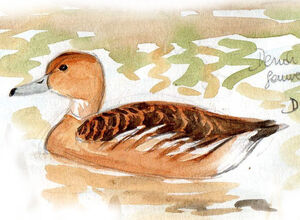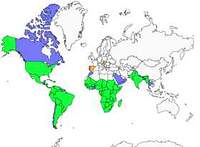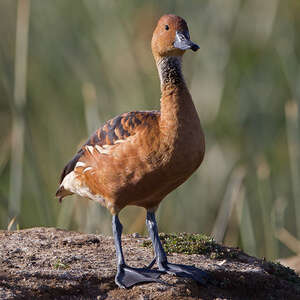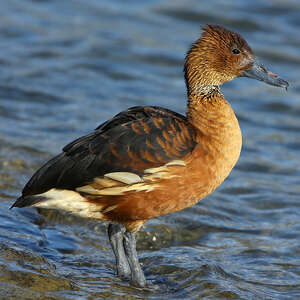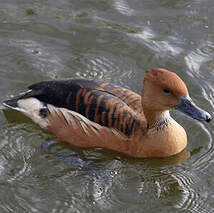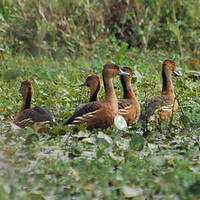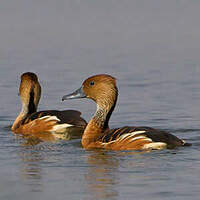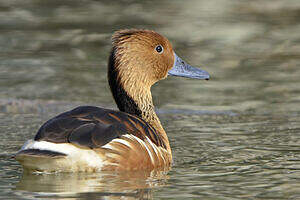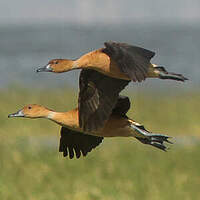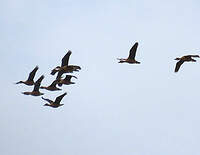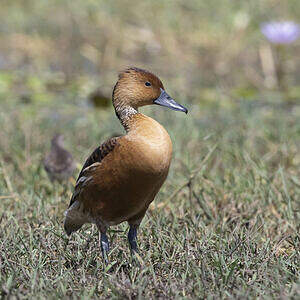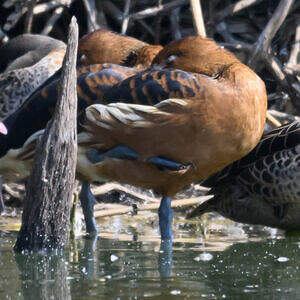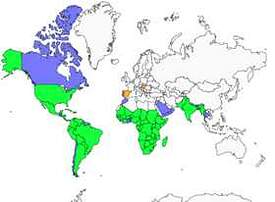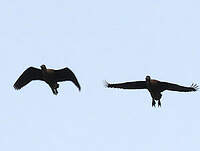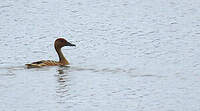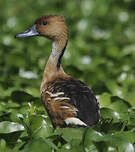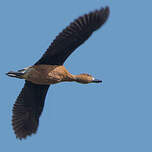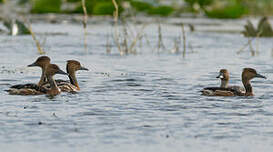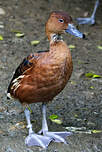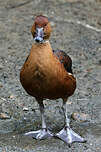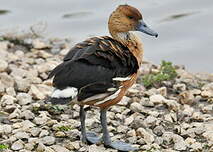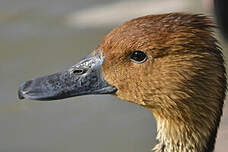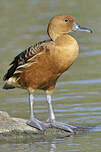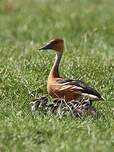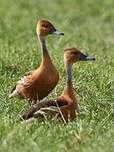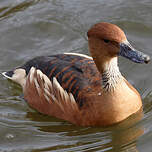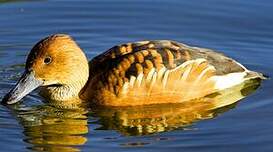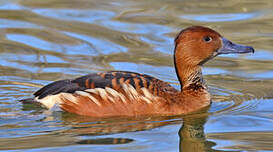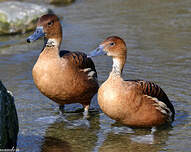Fulvous Whistling Duck
Dendrocygna bicolor - Dendrocygne fauve
Identification
Fulvous Whistling Ducks can't be confused with any other species of whistling duck or any other species of Anatidae. Only the whistling duck can be confused with the juvenile of our species. There is no sexual dimorphism. The overall appearance of the adult is reddish-brown with a darker back. The head is orange, the chin and throat are slightly white with black stripes forming a wide collar, the cap is a darker red and a brown line runs down the neck and widens at the bottom. The chest is orange-beige and the belly tends to darken slightly but still maintain the same tones. The undertail and undertail coverts are lightly tinted beige. The flank feathers are white, like long, pointed flames rising to the upper parts. The tips of the rectrices and the upper parts are brown. Reddish fringes on the tips of the smaller and medium coverts mix with the dark tones of the upper parts. These fringes tend to disappear on the tips of the blackish primary feathers. The rump is also dark. Standing and looking back, a pale white-beige crescent formed by the rectrices appears, in the middle the rump and the tail are black. The underside of the wing is blackish. The bill is blue-gray, the nail is black. The iris is dark brown, the eye has a light blue-gray orbital ring. The long legs are dark gray.
The female is similar to the male but duller. The only more or less visible difference, when the two individuals of the couple are together, is the brown line behind the neck that goes up to the cap in the female but is interrupted on the neck in the male.
The nest-fleeing chick is brown on the body and head. The cheeks are yellowish-white with a horizontal brown line in the middle.The chin and throat are white.
Subspecific information monotypic species
Foreign names
- Dendrocygne fauve,
- Suirirí bicolor,
- dendrocisne-bicolor,
- Gelbbrust-Pfeifgans,
- sujtásos fütyülőlúd,
- Rosse Fluiteend,
- Dendrocigna fulva,
- brun visseland,
- Brunplystreand,
- stromárka hrdzavá,
- husička bažinná,
- Okkertræand,
- ruskoviheltäjäsorsa,
- Fluiteend,
- ànec arbori bicolor,
- Barkarblístra,
- drzewica dwubarwna,
- rūsganā svilpējzoss,
- rumeni žvižgač,
- Рыжая древесная утка,
- アカリュウキュウガモ,
- 茶色树鸭,
- 草黃樹鴨,
Voice song and call
Like all Fulvous Whistling Ducks, they are rather talkative and noisy, especially in a group. The sounds are mostly whistling. The most frequent calls are two or three syllabic with pi-wiiou, pit-pit-wiiu and pit-wiii being the most heard. Quarrels can be accompanied by repeated kep-kep-kep sounds. Females have shorter and less resonant notes at the end of their calls which makes it easier to tell apart males and females. At night, their whistles are caused by the flapping of their wings.
Habitat
The Fulvous Whistling Duck is looking for freshwater or brackish wetlands as well as shallow marshes. These wetlands include freshwater lakes, slow streams, flooded meadows, marshes and willingly rice fields. In all these habitats it is dense and tall vegetation that it seeks to ensure its protection during the breeding and molting. More mountainous species (up to 4,000 meters in Peru), it is found around 300 meters in Venezuela.
Behaviour character trait
Widely distributed worldwide, the Fulvous Whistling Duck remains a local migrant and is able to perform long distances as long as it doesn't find favourable habitats.
The population in Madagascar, known to be sedentary, can migrate towards East and West Africa, this phenomenon being mostly related to pluviometry. The North American population from the Gulf of Mexico, instead, winters in the south of the country. Outside of the nesting periods, it moves in dispersed small groups. Irrespective of the geographical zone, moulting takes place after nesting. The wing feathers are all replaced at the same time, which renders birds incapable of flying. They take refuge among grasses, in small groups, by hundreds or by thousands. The feathers of the body are moulted throughout the year. The species is very active both during the day and the night. Food search takes place during the two first hours following the rising of the sun, and two hours before dusk, usually with other species of dendrocygnes. It walks perfectly without swaying.Flight
Dietfeeding habits
The Fulvous Whistling Duck is a vegetarian species. It feeds on aquatic seeds, fruits, bulbs, buds, and some parts of grasses and reeds, but it sometimes catches a few insects. But what it prefers the most is rice grains. Unfortunately for the farmers, it feeds directly from rice fields and causes considerable damage. It looks for food among the vegetation while swimming and rummaging around. It can even dive up to one meter deep if necessary.
Reproduction nesting
The nesting period is closely related to periods of rain and availability of wetland areas. However, populations from the north of the Zambezi River in Austrail Africa reproduce when precipitation is lower, while those to the south reproduce during the wet season. The Fulvous Whistling Duck reproduces in pairs or small groups. It is faithful for life. Courtship is relatively short. The pair will preen each other's heads before mating, and then perform a rapid dance in which both adults lift their bodies above the surface of the water. In North America, migratory birds reach nesting areas between February and April.
Laying begins in early April and continues until early July, sometimes even into late August. In South America and South Africa, the nesting period is from December to February. In Nigeria, it is from July to December. In India, it corresponds to the monsoon season from June to October, with a peak in July-August. The nest is built from various vegetable materials, forming a mound floating on the water, well sheltered in dense vegetation. The female lays about 10 whitish eggs at a rate of one egg every 24 to 36 hours and begins even before the nest construction is completed, resulting in some losses. Some nests can hold more than 20 eggs when other females are coming to lay in the nest. Both adults incubate, taking turns at least once a day. The male has a great importance in this task. Incubation lasts 24 to 29 days. Young remain with the adults for the first 9 weeks, by the end of which they are able to fly. They are sexually mature at the age of one year. In India, the Fulvous Whistling Duck can mix with the much more numerous Whistling Ducks and nest more easily in tree hollows or old nests of raptors or crows.Geographic range
The Fulvous Whistling Duck is the only one of its species to have such a wide range. Indeed, it can be found on the four continents of the world. In Asia, it is present in Pakistan, India, Nepal, Bangladesh and Burma, with populations of around 50,000 individuals. It is present throughout Africa, starting from the Sahel, with 170,000 to 390,000 individuals counted in 2014. In this part of the world, it avoids the wooded areas of the Atlantic coasts and the too arid areas. A sedentary population is known to exist in Madagascar. Finally, it is present throughout the American continent and individuals have been signaled in Morocco and Spain, even if they cannot be counted amongst the natural visitors, due to the number of captives that have escaped, even if there have been cases of occasional nesting.
Threats - protection
IUCN conservation status
concern
in the Wild
threatened
evaluated
Several threats weigh on the Fulvous Whistling Duck. First, natural ones on the young. They are indeed prey to many mammals, birds and reptiles. The species is then heavily persecuted and hunted by man in the areas where rice is cultivated. It is also exposed to the many pesticides used in these rice fields. Other hunts, such as poaching for traditional medicine in Nigeria or hunting for local consumption in Malawi, are reducing the numbers of the populations. Collisions with power lines are also not rare. The modification of its habitat in India or Africa affects its populations. Finally, it is very sensitive to avian botulism. In addition to this decrease in the global population, it is not fast enough to categorize the species as vulnerable. The IUCN has categorized it as of least concern and it is one of the species included in the AEWA (Agreement on the Conservation of African-Eurasian Migratory Waterbirds).
Sources of information
- IOC World Bird List (v14.2), Gill, F and D Donsker (Eds). 2024-04-18.
- Canards, cygnes et oies d'Europe, d'Asie et d'Amérique du Nord, Reeber Sébastien
- BirdLife International, BirdLife International
- Wikipedia (English version),
Other sources of interest
 Specification sheet created on
24/07/2023 by Nathalie Santa Maria
Specification sheet created on
24/07/2023 by Nathalie Santa MariaTranslation by AI Oiseaux.net
© 1996-2025 Oiseaux.net
- Accipitriformes
- Aegotheliformes
- Anseriformes
- Apodiformes
- Apterygiformes
- Bucerotiformes
- Caprimulgiformes
- Cariamiformes
- Casuariiformes
- Charadriiformes
- Ciconiiformes
- Coliiformes
- Columbiformes
- Coraciiformes
- Cuculiformes
- Eurypygiformes
- Falconiformes
- Galliformes
- Gaviiformes
- Gruiformes
- Leptosomiformes
- Mesitornithiformes
- Musophagiformes
- Nyctibiiformes
- Opisthocomiformes
- Otidiformes
- Passeriformes
- Pelecaniformes
- Phaethontiformes
- Phoenicopteriformes
- Piciformes
- Podargiformes
- Podicipediformes
- Procellariiformes
- Psittaciformes
- Pterocliformes
- Rheiformes
- Sphenisciformes
- Steatornithiformes
- Strigiformes
- Struthioniformes
- Suliformes
- Tinamiformes
- Trogoniformes

